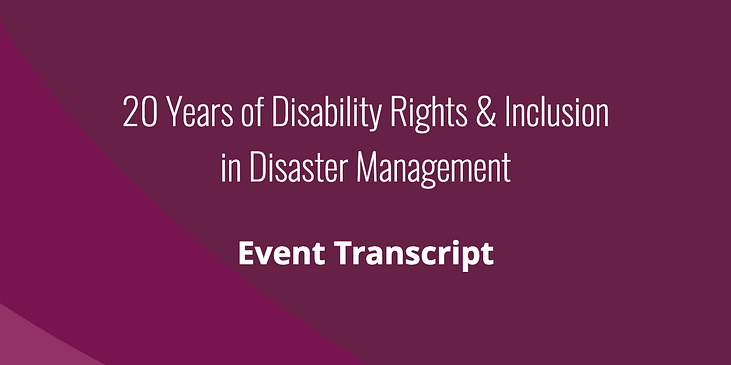20 Years of Disability Rights & Inclusion
in Disaster Management
Event Transcript
>[AUDIO DESCRIPTION]: 20 years of Disability Rights and Inclusion in Disaster Management: Global Rights and Collaboration
>>MARCIE ROTH: I had the incredible opportunity to spend just about eight years at FEMA, I was appointed in the Obama administration. It was a huge honor to go to FEMA as Senior Advisor to FEMA administrator Craig Fugate. Craig gave me the room to take on a transformational approach to preparedness, response, recovery – not for people with disabilities but with us, both in the US and globally.
We established the Office of Disability Integration and Coordination, I was given funding to hire 285 disability integration specialists. I had the opportunity to get involved in the – what was becoming the Sustainable Development Goals and the particular focus on disaster risk reduction, and that then became the Sendai Framework for Disaster Risk Reduction, which you know, the Sustainable Development Goals are a 15-year plan with targets, the Sendai Framework for Disaster Risk Reduction was the first specific focus following the global commitment to the Sustainable Development Goals. I had been quite involved in the U.S. response after the Great East Earthquake in Japan in 2010, then during the Global Platform in 2015 I traveled as part of the U.S delegation to Sendai where a whole bunch of disability leaders from around the globe, we had all been working together on the drafts leading up to the framework. We had very successfully embedded not just the needs of people with disabilities in disaster risk reduction, but very specifically the recognition that people with disabilities are most knowledgeable and need to be not only at the table but in leadership roles and then I’ve had the great opportunity to continue to focus on that. The UN Secretary General a couple years ago established the UN’s Disability Inclusion Strategy, four pillars and 15 indicators of disability inclusion throughout all of the UN agencies, and I had the great opportunity to be the consultant helping the UN Office for Disaster Risk Reduction to launch their Disability Inclusion Strategy.
When I came to WID just about two years ago, one of the things that our board asked of me was to bring a focus on disability and disasters, climate justice, to the work that WID is doing. One of the things that I had recognized over this period was that local disability-led organizations almost never have access to the resources of humanitarian relief in disasters. And so we decided as part of WID’s strategy that we were going to launch a Global Alliance for Disaster Resource Acceleration cutting out all the middle pieces and bringing corporations and foundations directly together with local disability-led organizations to help those organizations continue their operations and to support their community, not as a charitable approach, which is what a lot of humanitarian relief is, but rather as a tool for community strengthening. These local organizations deal with the big challenges of their local community on a daily basis. And we’re now just a little more than a year after launching the Global Alliance for Disaster Resource Acceleration or as we’re now fondly calling it, GADRA. GADRA and our work in preparedness, disaster risk reduction, and climate justice, they’re certainly all about disability, but they’re really about social justice. They’re really about a much more just world centering on the people who need us to get it right the most.
If you are having technical issues or accessibility issues on this site, email wid@wid.org.
Main content end


0 comments on “Transcript for “20 Years of Disability Rights & Inclusion in Disaster Management: Global Rights and Collaboration””